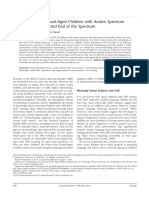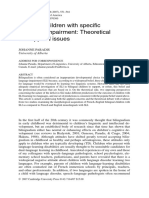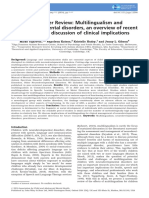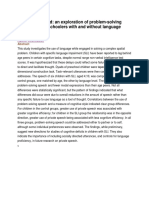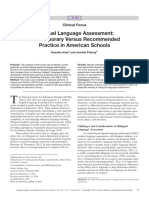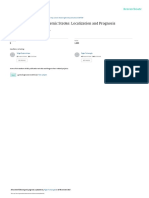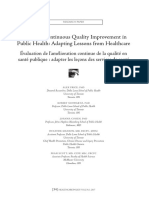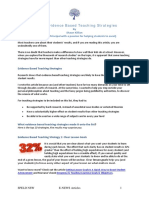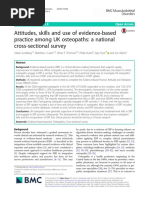Critical Review: Effects of Mild To Moderate Sensorineural Hearing Loss On The Language Development of School Aged Children
Critical Review: Effects of Mild To Moderate Sensorineural Hearing Loss On The Language Development of School Aged Children
Uploaded by
Ersya MusLih AnshoriCopyright:
Available Formats
Critical Review: Effects of Mild To Moderate Sensorineural Hearing Loss On The Language Development of School Aged Children
Critical Review: Effects of Mild To Moderate Sensorineural Hearing Loss On The Language Development of School Aged Children
Uploaded by
Ersya MusLih AnshoriOriginal Description:
Original Title
Copyright
Available Formats
Share this document
Did you find this document useful?
Is this content inappropriate?
Copyright:
Available Formats
Critical Review: Effects of Mild To Moderate Sensorineural Hearing Loss On The Language Development of School Aged Children
Critical Review: Effects of Mild To Moderate Sensorineural Hearing Loss On The Language Development of School Aged Children
Uploaded by
Ersya MusLih AnshoriCopyright:
Available Formats
Copyright @ 2012 , Hillier, J.
Critical Review: Effects of mild to moderate sensorineural hearing loss on the language development of
school aged children
John Hillier
M.Cl.Sc (AUD) Candidate
University of Western Ontario: School of Communication Sciences and Disorders
Language development, in school aged children with permanent mild to moderate sensorineural hearing loss
(MMSHL), has been given little consideration with few studies devoted to the subject. Children with MMSHL often
face many obstacles in the domain of language development as the characteristics of their hearing loss often lead to
language input being degraded and distorted. This critical review examines the research on the effects of MMSHL
on normal language development. The selected research papers address the effects of minimal and moderate
permanent hearing loss on certain factors of language development in school aged children and if these language
delays persist as the child ages. The research concludes that children with MMSHL do perform poorly in certain
linguistic skills, such as phonology and syntax. Three of the four studies included in this paper linked poor
performance in these areas to more complex difficulties in language and communicative ability.
MMSHL has been associated with deficiencies in
Introduction frequency discrimination, expressive language and in
production of verb morphology. It has also been
Recently, it has been suggested by a number of concluded that children with MMSHL experience
researchers that mild to moderate bilateral sensorineural difficulties in phonological processing (Moeller,
hearing loss (MMSHL) does have a significant effect on McCleary, Putman, Tyler-Krings, Hoover &
the language development of a school aged child. Stelmachowicz, 2010). Due to a number of
Despite this discovery there have been few studies misconceptions concerning children with MMSHL
conducted to investigate and define the precise educators and other professionals may conclude that
difficulties that may arise. Due to the dearth of these children may not be suffering any major
published research there remains a lack of awareness by difficulties due to their hearing loss. However, it should
professionals who work with school aged children as to be realized that the disrupted auditory input due to
how these difficulties exactly affect normal language MMSHL that occurs during the time of normal language
development. development may cause deficiencies and delays in
certain linguistic skills (Norbury, Bishop & Briscoe,
Briscoe, Norbury and Bishop (2001) define mild 2001).
hearing loss as a pure tone average threshold of 20 dB
HL to 40 dB HL whereas their definition of moderate Objectives
hearing loss is thresholds ranging from 40 dB HL to 70
dB HL. Presently, this definition is universally accepted The primary objective of this paper is to critically
amongst researchers. In the past, the primary focus of review selected studies that present evidence concerning
research, for a number of reasons, was on the the effects of mild to moderate sensorineural hearing
management of children with severe to profound loss on the language development of school aged
hearing loss. With advancements in hearing assessment children. A secondary objective is to identify and
and screening and the ability to reliably detect milder discuss the clinical implications of this research.
losses, researchers have begun to turn their attention to
populations with less severe hearing loss. Until the Methods
1980s and the initial work of Fred Bess it was the
prevalent belief that school aged children, who suffer Search Strategy
from milder degrees of sensorineural hearing loss, do The following databases were included in the literature
not experience any considerable difficulties in language search:, PubMED and Medline. The search strategy was
development (Tharpe, 2008). However, current research as follows:
now indicates that these children may have significant (mild to moderate hearing loss) AND (sensorineural
difficulties in a number of aspects of language hearing loss) AND (language development)
development which could possibly have far reaching Limitations on the search included: studies in English
effects on the child’s communicative ability and and all children (0-18 years). Google Scholar was used
scholastic achievement throughout the individual’s life to supplement the search of academic databases to
(Delage & Tuller, 2007). Research has shown that identify any obscure or grey literature.
Copyright @ 2012 , Hillier, J.
Selection Criteria younger. This led the researchers to conclude that
Articles selected for this review included studies that degraded auditory input during this period of language
researched the effects of mild to moderate sensorineural acquisition may cause delays in the development of
hearing loss on the language development of school certain language skills.
aged children.
Data Collection Briscoe et al. (2001)
The articles that corresponded to the above literature In this paper, the researchers use a case-control study to
search and met the selection criteria included three case assess and compare the phonological skills, language
control studies that investigated the effects of mild to ability and literacy scores of children with MMSHL and
moderate sensorineural hearing loss on language, children with SLI. The two clinical samples were
literacy and various linguistic skills such as phonology, recruited and compared with two control groups of
morphosyntax and morphology. The fourth article normally developing children. Included in the MMSHL
retrieved involved longitudinal research on the language group were children who had a mild (PTA 20-40 dB
development of children with late identified mild to HL) to moderate (41-70 dB HL) bilateral sensorineural
moderate hearing loss. Two of these articles (Moeller et hearing impairment, were attending mainstream school
al, 2010; Delage and Tuller, 2007) also investigated the and were not using sign language. Each child was
normalization of language skills in adolescents with administered a battery of tests including standardized
MMSHL. language assessments as well as tests of phonological
awareness, phonological discrimination, expressive
Results phonology and digit recall. Scheffe tests set at p < .05
Children with MMSHL and development of language showed very few significant differences between the
Norbury et al. (2001) MMSHL group and the SLI groups. It was shown that
In this study, Norbury et al. compare the production of the MMSHL group and the SLI group were equally
verb morphology of two groups: children with specific impaired on tests of phonological awareness,
language impairment (SLI) and children with MMSHL. phonological discrimination and nonword repetition.
The authors of this paper are interested in However, the MMSHL group did not show any of the
morphological development in children with moderate deficiencies in language and literacy which were
degrees of hearing loss. Their research is primarily prominent in the SLI group. Subsequently, the
concerned with how degraded auditory input affects researchers analyzed the data of the hearing impaired
learning of finite verb morphology. This study included group based on whether they were impaired or
four groups of children: a MMSHL group, a SLI group unimpaired on the phonological tasks. This was to
and two control groups. It should be noted that one further examine the extent certain factors, such as,
control group was matched on age and nonverbal ability severity of hearing loss, age of diagnosis of hearing
to the SLI and MMSHL groups and the other was loss, or general cognitive ability have on phonological
matched on language-age to the SLI group. deficits in children with MMSHL. T-tests were
. conducted and no significant differences between the
The researchers used analysis of variance (ANOVA) to impaired and unimpaired groups in age were found:
compare group means on all language assessments. To unimpaired mean =8.78, impaired mean = 8.53 years;
identify patterns amongst the subgroups the post-hoc t(17)=0.39, p=.0705. The two groups also did not differ
Scheffe test was conducted. Results revealed that on age at diagnosis of hearing loss: 49.2 months for
children in the MMSHL group had most difficulty on those without phonological impairments: 47.1 months
measures of expressive language. This group also for those with phonological impairments. However, the
scored significantly poorer on measures of phonological two groups did differ in degree of hearing loss. ANOVA
processing than the age matched control group [F(3, 62) showed a significant effect of subgroup, F(1, 17) = 7.56,
= 9.26, p <.001 ƞ2 =.309]. A series of t-tests was p = .014 but no interaction between subgroup and
conducted to identify differences in the MMSHL group. frequency, F (4,68) = 0.29, p=.280. The study showed
The groups were determined depending on whether the that there were some differences in language literacy
children were impaired or unimpaired on tense marking skills, with the phonologically impaired group
tasks. It was shown that the impaired group (6 children) performing worse. However, the researchers ultimately
and the unimpaired group (13 children) differed concluded that, despite there being a link between poor
significantly on language measures such as receptive phonological awareness and phonological
vocabulary and grammar, expressive verb vocabulary discrimination with vocabulary acquisition, there is no
and phonological discrimination. T-tests also showed relation between poor performance on phonological
that these two groups differed significantly in age tasks and other language abilities or literacy.
(t=3.99, p=.001) with the impaired group being
Copyright @ 2012 , Hillier, J.
production of morphological errors. At baseline, all four
Delage and Tuller (2007) of the children with MMSHL fell below the lower limits
The purpose of this study was to evaluate the nature of of the 95% confidence interval for the control group.
the link between hearing loss and language impairment One of the questions the researchers explored was
in adolescents with mild-to-moderate hearing loss. whether the spoken language skills of the MMSHL
Nineteen monolingual French speakers ranging in age group normalized with age. Results indicated that with
from 11 to 15 years were recruited. All subjects suffered age and intervention three of the four children showed
from bilateral sensorineural hearing loss with thresholds improvement. However, the researchers further reported
between 27 dB to 69 dB. These adolescents were that delays persisted in speech production, production of
compared to two control groups and a group of children fricatives and morphology. They believe these results
with SLI. Language and literacy skills were assessed are attributable to the combination of degraded
with a battery of standardized tests including tests of audibility and reduced auditory experience due to the
phonology, as assessed by a word repetition task, hearing impairment during the early period of language
expressive grammar and reading. To define language acquisition.
impairment, scores on the standardized tests were
converted to z scores. The authors chose the threshold of Critical Appraisal of Selected Case Control Studies
< -1.65 SD which corresponds to the fifth percentile in Case control studies are designed to explore factors that
the normal distribution as the cutoff score for difficulty. contribute to a certain condition of a patient by
Scores on these tests showed that adolescents with comparing patients with the condition of interest (case)
MMSHL had difficulties with phonology (63. 2% to patients who do not present with the condition
participants with scores < - 1.65 SD) and morphosyntax (controls). The Oxford Centre for Evidenced Based
(31.6% with scores < -1.65 SD). Similar difficulties Medicine place case control studies as level 2b
were seen in the SLI group but not the control groups. evidence. It is expected that studies ranked this highly
There were few difficulties seen in other language in the Oxford Hierarchy should yield valid and
skills, such as oral comprehension, written language and important evidence. Greenhalgh (1997) suggests that the
vocabulary for the MMSHL group. Spearman two most important factors of the research design of a
correlation tests were conducted to determine links case control study to consider are the diagnosis of
between language performance and other variables. A “caseness” and how the decision of when the individual
link was found with degree of hearing loss and became a case is made.
performance in expressive grammar (r = -.51, p <..05)
and in word repetition (r =-.61, p<.01). Subjects with Strengths of Selected Case Control Studies
higher degrees of hearing loss performed worse on these All of the case control studies selected for this paper
measures. Results from this study showed that more employ sensible research design and explore pertinent
than half of the children in the MMSHL group and salient questions, which have rarely been
performed poorer than control groups in areas of investigated. The researchers of the case control studies
phonology and grammar and language scores were have used statistical analysis to show that the results
linked to degree of hearing loss. were statistically significant, thus increasing the validity
of the evidence. For example, Delage and Tuller (2007)
Longitudinal study of language development and use the nonparametric Wilcoxon test appropriately to
language normalization analyze within groups data. The studies also define the
Moeller at al. (2010) characteristics of the groups being investigated. In their
This study was the first longitudinal study that paper, Briscoe et al. (2001) clearly outline the
examined the effects that late-identified mild-moderate thresholds of the children in the MMSHL group. The
hearing loss can have on a child’s language researchers also attempt to limit confounding factors by
development. Longitudinal measures were taken excluding children with certain characteristics such as
throughout the study and changes were noted and neurological impairment or other comorbidities. To
analyzed. Baseline results indicated that, as compared to further strengthen the evidence presented researchers
the normally developing control group, the hearing attempted to match the case and control groups on
impaired children performed poorly on measures of factors such as age and other characteristics such as
phonology. In particular, all four of the MMSHL nonverbal ability. All language assessments were
children had difficulty producing fricatives and the standardized and significant bias in outcome assessment
immaturity of their consonant inventories, suggested is unlikely for the selected studies.
marked delays in consonant production. The deficits in
phonology were also accompanied by impaired Limitations of Selected Case Control Studies
production of morphology for three of the children in The research designs of the studies did also include
the MMSHL group as evidenced by the persistent some limitations. One limitation of the study conducted
Copyright @ 2012 , Hillier, J.
by Norbury et al. (2001) involves the fact that the phonology and syntax are most prevalent as these
researchers only recruited students from mainstream language skills are the most susceptible to atypical
schools to take part in their research. This could result development during this period. It must be noted that
in sampling error and confound the results of the study. there is a great deal of intersubject variability and not all
To avoid this problem, the researchers could have children with MMSHL suffer from delays in language
recruited subjects from both mainstream schools and development or show long term effects (Delage &
children who were educated in specialist units. Tuller, 2007). A number of researchers have concluded
Additionally, the sample sizes for all three case control that children with MMSHL are at increased risk for
studies were relatively small (19-20 children for each psychoeducational deficits and poor scholastic
study). This limitation could negatively impact the achievement (Tharpe, 2008). This statement is in
power used to accurately make conclusions about the contrast with the findings of certain studies identified in
effects of the condition. this paper. Briscoe et al. (2001) found that the
deficiencies in phonology and expressive language
Critical Appraisal of Longitudinal Study found in some of the children suffering from MMSHL
The selected longitudinal study was a comparative study could not be linked with large scale problems in
with concurrent controls and is therefore ranked as level language and literacy. However, Delage and Tuller
2b evidence according to the Oxford Centre for (2007) suggest that long term impairments in language
Evidence based medicine hierarchy. Strengths of this development due to degraded auditory input, may be
study include the design. For example, children with severe enough for some adolescents with MMSHL, to
hearing loss were age-matched and compared to experience delays in school. Moeller et al. (2010) have
children with normal hearing. Baseline measures were similar findings to those of Delage and Tuller. In their
taken near the point of identification and standardized longitudinal study, these researchers found that, despite
measures of language assessment were used. The the normalization of certain linguistic skills, their group
limitations of this study include a small sample size of children with late identified MMSHL still had
(n=4) and the fact that the authors of this study did not persistent delays in speech intelligibility. This
use any statistical methods to determine if there were impairment in speech intelligibility was compounded by
any significant differences between the impaired difficulties in phonological skills, especially the
hearing group and the normal hearing group. production of fricatives, and morphology. Research has
shown that children with such difficulties are prone to
Having considered the strengths and weaknesses of each speech errors and have difficulty making themselves
study, the research presented in the case control studies understood due to a lack of vocabulary (Tharpe, 2008).
can be categorized as compelling. However, due to a It is therefore possible that these deficits could
small sample size and lack of statistical analysis the negatively affect the communicative ability and
evidence presented in the longitudinal study could be psychoeducational development of these children.
considered suggestive.
Discussion Clinical Implications
There are a number of clinical implications which arise
All four of the papers examined in this study found from the research surveyed in this paper. Firstly,
fairly strong evidence of significant differences between awareness is an issue when it comes to the effects of
children with MMSHL and normally developing MMSHL on natural language development. Studies
children in the domain of language development. The conducted on this subject are rare and there are certain
majority of these difficulties involved impairments in myths surrounding the development of children with
phonology and expressive language. Two of the studies MMSHL because of this lack of knowledge. Many
(Delage & Tuller, 2007: Moeller et al., 2010) found professionals believe that preferential seating in front of
evidence that adolescents with MMSHL may still the classroom is sufficient for children with MMSHL
display relatively severe language impairments. This (Goldberg & Richburg, 2004). Teachers and other
would indicate that delays in language development professionals should be advised that degraded auditory
persist in certain children. It has been shown that the input has been shown to affect the language
language skills of these children do improve with age, development of children with MMSHL. Therefore other
as compared to younger children with MMSHL, considerations, such as FM systems, should be made in
however they do continue to show poorer performance order to ensure that the child is receiving proper
than their normally developing peers on certain auditory input.
language production tasks. The early school years
encompass the critical period for language development Secondly, at this moment, many universal newborn
(6 to 7 years). It is this reason that impairments in hearing screening programs are deigned to identify
Copyright @ 2012 , Hillier, J.
moderate or worse sensorineural hearing loss and often Delage, H. & Tuller, L. (2007). Language development
consider children with milder degrees of hearing loss as and mild-to-moderate hearing loss: does
unwanted false positive results (Wake, 2006). These language normalize with age? Journal of
guidelines may need to be reviewed as Moeller et al. Speech, Language and Hearing Research, 50,
(2010) show that children with late identified MMSHL 1300-1313.
demonstrate language delays. Goldberg, L. & Richburg, C. (2004). Minimal hearing
impairment: major myths with more than
Conclusion minimal implications. Communication
The findings of the research discussed above indicate Disorders Quarterly, 25, 152.
that children with MMSHL have difficulty in their Greenhalgh, T. (1997). Assessing the methodological
development of certain linguistic skills. Furthermore, a quality of published papers. British Medical
number of the studies linked these deficits with more Journal, 315, 305-308.
complex difficulties in language and communicative Moeller, M., McCleary, E., Putman, C., Tyler-Krings, A
ability. However, additional research should be Hoover, B., & Stelmachowicz, P. (2010).
conducted to identify factors which would predict which Longitudinal development of phonology and
children with MMSHL would be at highest risk for morphology in children with late-identified
these difficulties as there is much intersubject variability mild-moderate sensorineural hearing loss. Ear
within this population. Increasing awareness in teachers and Hearing. 31, 625-635.
and other professionals who work with children with Norbury, C., Bishop, D., & Briscoe, J. (2007).
MMSHL as to difficulties that these children may Production of English finite verb morphology:
experience would also be recommended for the future. a comparison of SLI and Mild-Moderate
Hearing Impairment. Journal of Speech,
Language and Hearing Research, 44, 165-178.
Tharpe, A. Unilateral and mild bilateral hearing loss in
children: past and current perspectives. (2008).
References Trends in Amplification, 12. 7-15.
Briscoe, J, Bishop, D. & Norbury, C. (2001). Wake, M., Tobin, S., Cone-Wesson, B., Dahl, H.,
Phonologial processing, language and literacy: Gillam, L., McCormick, L., Poulakis, Z.,
a comparison of children with mild-to- Rickards, F., Saunders, K., Ukoumunne, O &
moderate sensorineural hearing loss and those Williams, J. (2006). Slight/Mild hearing loss in
with specific language impairment. Journal of children. Pediatrics, 118, 1842-1851.
Child Psychology, 42, 329-340.
You might also like
- 5426 PDF PDFDocument4 pages5426 PDF PDFErsya MusLih AnshoriNo ratings yet
- Stroke - Practical Management 3rd EdDocument998 pagesStroke - Practical Management 3rd Edprasad616100% (13)
- Languaje Disorder in Children Whith Unilateral Hearing LossDocument6 pagesLanguaje Disorder in Children Whith Unilateral Hearing LossLeticia Zendejas DomínguezNo ratings yet
- 33 Current KnowledgeDocument14 pages33 Current KnowledgeSyukriNizamNo ratings yet
- Do Audiologic Characteristics Predict Outcomes in Children With Unilateral Hearing LossDocument8 pagesDo Audiologic Characteristics Predict Outcomes in Children With Unilateral Hearing LossRawanNo ratings yet
- Expressive Vocabulary Morphology SyntaxDocument15 pagesExpressive Vocabulary Morphology SyntaxHafidz Triantoro Aji PratomoNo ratings yet
- Impactbilingualism JADD 2012 Hambly Fombonne PDFDocument12 pagesImpactbilingualism JADD 2012 Hambly Fombonne PDFclaudiaNo ratings yet
- Final Research Paper - VosDocument16 pagesFinal Research Paper - VosAnna VosNo ratings yet
- Autism Research - 2013 - Tager Flusberg - Minimally Verbal School Aged Children With Autism Spectrum Disorder TheDocument11 pagesAutism Research - 2013 - Tager Flusberg - Minimally Verbal School Aged Children With Autism Spectrum Disorder Thezzzzz zzzzz zzzzzNo ratings yet
- Working Memory and Novel Word Learning in Children With HI & SLIDocument22 pagesWorking Memory and Novel Word Learning in Children With HI & SLIBayazid AhamedNo ratings yet
- Empirical Study Children With SLI Can Exhibit Reduced Attention To A Talker's MouthDocument13 pagesEmpirical Study Children With SLI Can Exhibit Reduced Attention To A Talker's MouthPaul AsturbiarisNo ratings yet
- Intensidad EntrenamientoDocument18 pagesIntensidad EntrenamientoJose Luis Ceballos LunaNo ratings yet
- Prosodia, Música y Habilidades Leng ICDocument16 pagesProsodia, Música y Habilidades Leng ICMarce MazzucchelliNo ratings yet
- Bettcher Apsy 652 Term PaperDocument13 pagesBettcher Apsy 652 Term Paperapi-162509150No ratings yet
- Unidad 3 5Document18 pagesUnidad 3 5Trinni GuzmanNo ratings yet
- Language Outcomes in Young Children With Mild To Severe Hearing LossDocument44 pagesLanguage Outcomes in Young Children With Mild To Severe Hearing Loss21 TMHNo ratings yet
- Kiese HimmelDocument9 pagesKiese HimmelhassaniNo ratings yet
- Gillon 2000Document17 pagesGillon 2000Isabel Cinthia Guerrero PintoNo ratings yet
- Down Syndrome 2Document19 pagesDown Syndrome 2Renelli Anne GonzagaNo ratings yet
- Nordgren 2014Document27 pagesNordgren 2014Bianca PintoNo ratings yet
- Phonological Processes in The Speech of School-Age Children With Hearing LossDocument13 pagesPhonological Processes in The Speech of School-Age Children With Hearing Lossmajid mirzaeeNo ratings yet
- Bilingual Children With Specific Language Impairment: Theoretical and Applied IssuesDocument14 pagesBilingual Children With Specific Language Impairment: Theoretical and Applied IssuesCatnis TomNo ratings yet
- Ni Hms 586500Document15 pagesNi Hms 586500Enggar adi nugrohoNo ratings yet
- Qualitative Aspects of Developmental Language Impairment Relate To Language and Literacy Outcome in AdulthoodDocument23 pagesQualitative Aspects of Developmental Language Impairment Relate To Language and Literacy Outcome in AdulthoodΔήμητρα Καραγιαννοπούλου100% (1)
- WolkandBrennan PhonoInvestigationAutism 2013Document9 pagesWolkandBrennan PhonoInvestigationAutism 2013ALEXANDRE BARBOSANo ratings yet
- Gather Cole 1993Document14 pagesGather Cole 1993HocvienMAENo ratings yet
- Botting Conti-Ramsden 2001Document13 pagesBotting Conti-Ramsden 2001Gaby HerreraNo ratings yet
- Practitioner Review - Multilingualism and Neurodevelopmental Disorders, An Overview of Recent Research and Discussion of Clinical ImplicationsDocument13 pagesPractitioner Review - Multilingualism and Neurodevelopmental Disorders, An Overview of Recent Research and Discussion of Clinical ImplicationsAndrea Gallo de la PazNo ratings yet
- Kelley Mccann 2021 Language Intervention Isn T Just Spoken Assessment and Treatment of A Deaf Signing Child WithDocument15 pagesKelley Mccann 2021 Language Intervention Isn T Just Spoken Assessment and Treatment of A Deaf Signing Child WithDaniela Rojas ramirezNo ratings yet
- Pediatrics 2013Document9 pagesPediatrics 2013Bella AgiusselaNo ratings yet
- Language Deprivation Syndrome: A Possible Neurodevelopmental Disorder With Sociocultural OriginsDocument16 pagesLanguage Deprivation Syndrome: A Possible Neurodevelopmental Disorder With Sociocultural OriginsRaul Morales VillegasNo ratings yet
- Development of Phonological, LexicalDocument18 pagesDevelopment of Phonological, LexicalcamilaNo ratings yet
- The Impact of A Dialogic Reading Program On Deaf and Hard-of-Hearing Kindergarten and Early Primary School-Aged Students in Hong KongDocument14 pagesThe Impact of A Dialogic Reading Program On Deaf and Hard-of-Hearing Kindergarten and Early Primary School-Aged Students in Hong Kongp.ioannidiNo ratings yet
- Auditory Processing Skills and PhonologiDocument19 pagesAuditory Processing Skills and PhonologilynneunlocksNo ratings yet
- Language Assessment in AutismDocument20 pagesLanguage Assessment in AutismDjamel DriciNo ratings yet
- Differences at 17 Months Productive Theo Van LeeuwenDocument14 pagesDifferences at 17 Months Productive Theo Van LeeuwenFernando FNNo ratings yet
- Sign LanguageDocument13 pagesSign LanguageKARINA ANGELICA CEDILLO MOLINANo ratings yet
- Language Assessment in Autism: Fernanda Dreux M.Fernandes, Cibelle A.H. Amato and Daniela R.Molini-AvejonasDocument21 pagesLanguage Assessment in Autism: Fernanda Dreux M.Fernandes, Cibelle A.H. Amato and Daniela R.Molini-AvejonasManuel VergaraNo ratings yet
- Deaf Children's Non-Verbal Working Memory Is Impacted by Their Language ExperienceDocument12 pagesDeaf Children's Non-Verbal Working Memory Is Impacted by Their Language ExperienceJoel Nathaniel Richard JosephNo ratings yet
- Specific Language Impairment (Sli)Document29 pagesSpecific Language Impairment (Sli)Aparna LVNo ratings yet
- Problemas Comportamentales y PragmaticaDocument9 pagesProblemas Comportamentales y PragmaticaLizeth Johana Restrepo SaldarriagaNo ratings yet
- S Ebbels 2013 CoordinadasDocument19 pagesS Ebbels 2013 CoordinadasmariaNo ratings yet
- Annotated BibliographyDocument9 pagesAnnotated Bibliographyjihanzhafira12No ratings yet
- Identifying Children at Risk For Language Impairment or Dyslexia With Group-Administered MeasuresDocument16 pagesIdentifying Children at Risk For Language Impairment or Dyslexia With Group-Administered MeasuresAfif RahmanNo ratings yet
- Language_and_Literacy_of_Deaf_ChildrenDocument21 pagesLanguage_and_Literacy_of_Deaf_ChildrentbdelatorreNo ratings yet
- Thinking Out Loud: An Exploration of Problem-Solving Language in Preschoolers With and Without Language ImpairmentDocument1 pageThinking Out Loud: An Exploration of Problem-Solving Language in Preschoolers With and Without Language ImpairmentRamil GofredoNo ratings yet
- Ministry of Higher Education and Scientific ReseqrchDocument14 pagesMinistry of Higher Education and Scientific ReseqrchkhawlabedraNo ratings yet
- Developmental Outcomes For Children at High Risk of Dyslexia and Children With Developmental Language DisorderDocument17 pagesDevelopmental Outcomes For Children at High Risk of Dyslexia and Children With Developmental Language DisorderValeska CeciliaNo ratings yet
- Down Syndrome PhonologyDocument9 pagesDown Syndrome PhonologyGerome ManantanNo ratings yet
- PublicationDocument10 pagesPublicationMaggy AstudilloNo ratings yet
- Ebd12r PDFDocument8 pagesEbd12r PDFVera Dyah SaputriNo ratings yet
- MerlinDocument30 pagesMerlinramandeep kaurNo ratings yet
- Dorothy V.M. Bishop-David McDonald-2009Document16 pagesDorothy V.M. Bishop-David McDonald-2009Inma MéndezNo ratings yet
- 5-Document14 pages5-psychreaserchNo ratings yet
- Autism Research - 2013 - Tager‐Flusberg - Minimally Verbal School‐Aged Children with Autism Spectrum Disorder TheDocument11 pagesAutism Research - 2013 - Tager‐Flusberg - Minimally Verbal School‐Aged Children with Autism Spectrum Disorder TheANN1020No ratings yet
- Lyytinen Et Al MPQ 52 3 2006 Lehden OmaDocument34 pagesLyytinen Et Al MPQ 52 3 2006 Lehden OmaDavid TorresNo ratings yet
- Topicsin Language Disorders 2011Document17 pagesTopicsin Language Disorders 2011Catarina GomesNo ratings yet
- (Research in Autism Spectrum Disorders 2014-Sep Vol. 8 Iss. 9) Hambly, Catherine - Fombonne, Eric - Factors InfluencingDocument11 pages(Research in Autism Spectrum Disorders 2014-Sep Vol. 8 Iss. 9) Hambly, Catherine - Fombonne, Eric - Factors InfluencingΣτέργιος ΚNo ratings yet
- Critical AnalysisDocument39 pagesCritical Analysisapi-283884559No ratings yet
- 2016 - LSHSS 15 0090 1 1Document15 pages2016 - LSHSS 15 0090 1 1ym2912No ratings yet
- Policy Brief 2 FinalDocument8 pagesPolicy Brief 2 FinalErsya MusLih AnshoriNo ratings yet
- Specific Language Impairment (SLI) Versus Speech Sound Disorders (SSD)Document2 pagesSpecific Language Impairment (SLI) Versus Speech Sound Disorders (SSD)Ersya MusLih AnshoriNo ratings yet
- Au Diver Baud CDDocument3 pagesAu Diver Baud CDErsya MusLih AnshoriNo ratings yet
- Audiology and Speech PathologyDocument2 pagesAudiology and Speech PathologyErsya MusLih AnshoriNo ratings yet
- Articulation DevelopmentDocument30 pagesArticulation DevelopmentErsya MusLih AnshoriNo ratings yet
- Kuback Oral Motor Exercises 08 PDFDocument15 pagesKuback Oral Motor Exercises 08 PDFErsya MusLih AnshoriNo ratings yet
- Speech-Language Pathology: Test at A GlanceDocument7 pagesSpeech-Language Pathology: Test at A GlanceErsya MusLih AnshoriNo ratings yet
- HHS Public Access: Intellectual Disability and Language DisorderDocument21 pagesHHS Public Access: Intellectual Disability and Language DisorderErsya MusLih AnshoriNo ratings yet
- 3403 6550 1 SMDocument17 pages3403 6550 1 SMErsya MusLih AnshoriNo ratings yet
- Dysarthria in Acute Ischemic Stroke: Localization and PrognosisDocument9 pagesDysarthria in Acute Ischemic Stroke: Localization and PrognosisErsya MusLih AnshoriNo ratings yet
- Chronic Illness and People With Intellectual Disability: Prevalence, Prevention and ManagementDocument42 pagesChronic Illness and People With Intellectual Disability: Prevalence, Prevention and ManagementErsya MusLih AnshoriNo ratings yet
- Language Handicaps in Children PDFDocument7 pagesLanguage Handicaps in Children PDFErsya MusLih AnshoriNo ratings yet
- About The AuthorDocument1 pageAbout The AuthorErsya MusLih AnshoriNo ratings yet
- Wright Marshall Wilson Aph2007Document17 pagesWright Marshall Wilson Aph2007Ersya MusLih AnshoriNo ratings yet
- Auditory Skill Hierarchy PDFDocument1 pageAuditory Skill Hierarchy PDFErsya MusLih AnshoriNo ratings yet
- Emotional Development in Children With Intellectual Disability - A Comparative Approach With "Normal" ChildrenDocument16 pagesEmotional Development in Children With Intellectual Disability - A Comparative Approach With "Normal" ChildrenErsya MusLih AnshoriNo ratings yet
- Chapter 1 The Practice of Medicine Harrisons Internal MedicineDocument11 pagesChapter 1 The Practice of Medicine Harrisons Internal Medicinenescafe1983No ratings yet
- Towards An International Framework For Communicati - 241107 - 143406Document15 pagesTowards An International Framework For Communicati - 241107 - 143406coookieee.09No ratings yet
- Medical Council Regulation Hgdhof IndonesiaDocument57 pagesMedical Council Regulation Hgdhof IndonesiaChristian Anantha Ginting MuntheNo ratings yet
- Headwall Systems, Prefabricated Service Columns, Prefabricated..Document40 pagesHeadwall Systems, Prefabricated Service Columns, Prefabricated..Ayman HassanNo ratings yet
- Doctorate in Educational and Child Psychology Martha Keogh: Page 1 of 43Document43 pagesDoctorate in Educational and Child Psychology Martha Keogh: Page 1 of 43Derek SaundersNo ratings yet
- A Nurse-Driven Protocol ForDocument8 pagesA Nurse-Driven Protocol ForWardah Fauziah El SofwanNo ratings yet
- Complete Download Psychiatric Nursing: Contemporary Practice 7th Edition Mary Ann Boyd & Rebecca Luebbert PDF All ChaptersDocument65 pagesComplete Download Psychiatric Nursing: Contemporary Practice 7th Edition Mary Ann Boyd & Rebecca Luebbert PDF All Chaptersyasnibedil100% (2)
- Afirm Module Paper AssignmentDocument6 pagesAfirm Module Paper Assignmentapi-449688524No ratings yet
- Grandes Desafios para A Prevenção e Reabilitação de Lesões EsportivasDocument5 pagesGrandes Desafios para A Prevenção e Reabilitação de Lesões EsportivasEdilis FlorNo ratings yet
- Final Draft Cancer Control Act IRR - Clean Version - 7aug2019Document33 pagesFinal Draft Cancer Control Act IRR - Clean Version - 7aug2019Ann Meredith Garcia TrinidadNo ratings yet
- Research MCQ'sDocument13 pagesResearch MCQ'szonishaadan2No ratings yet
- Physical Restraints and Side Rails in Acute and Critical Care Settings. in Evidence-Based Geriatric Nursing Protocols For Best Practice.Document11 pagesPhysical Restraints and Side Rails in Acute and Critical Care Settings. in Evidence-Based Geriatric Nursing Protocols For Best Practice.Madalina TalpauNo ratings yet
- Cqi in PHDocument16 pagesCqi in PHshaniaNo ratings yet
- Chapter 1 - 5 FinalDocument77 pagesChapter 1 - 5 FinalMark Ryan NagalesNo ratings yet
- Askep Jiwa Psikososial AnsietasDocument9 pagesAskep Jiwa Psikososial AnsietasDinny ApriliaNo ratings yet
- NursestaffDocument539 pagesNursestaffRosalyn WarrenNo ratings yet
- Ju: Cebs: Higher Diploma Programme For Teacher EducatorsDocument232 pagesJu: Cebs: Higher Diploma Programme For Teacher Educatorsmubarek oumerNo ratings yet
- Nursing-Associates-Proficiency-Standards 2Document30 pagesNursing-Associates-Proficiency-Standards 2Steve100% (1)
- Chap 3 TBDocument9 pagesChap 3 TBcrimsengreenNo ratings yet
- AOAPeerReview Pediatric Guideline Eye ExamDocument65 pagesAOAPeerReview Pediatric Guideline Eye ExambrontosaurpNo ratings yet
- Gender and Migration DataDocument64 pagesGender and Migration DataVicky LlorenteNo ratings yet
- Top 10 Evidence Based Teaching Strategies by Shaun KillianDocument7 pagesTop 10 Evidence Based Teaching Strategies by Shaun KillianCa EchaNo ratings yet
- Evidence-Based Practice and Research in NursingDocument4 pagesEvidence-Based Practice and Research in NursingCrazy StrangerNo ratings yet
- Professional PracticeDocument7 pagesProfessional PracticeMQ SpotifyNo ratings yet
- Week 9-11 (Nutrition)Document6 pagesWeek 9-11 (Nutrition)Yoko Mae YanoNo ratings yet
- Sundberg Et Al. BMC Musculoskeletal DisordersDocument10 pagesSundberg Et Al. BMC Musculoskeletal DisordersCrainlyNo ratings yet
- Establishment of A Policy Development Process at TheDocument63 pagesEstablishment of A Policy Development Process at TheFrederick NietzscheNo ratings yet
- Essay ExampleDocument5 pagesEssay ExampleJonatasPereiraSilvaNo ratings yet
- Approach To Nursing Assessment 1Document5 pagesApproach To Nursing Assessment 1Taiye OkondoNo ratings yet









